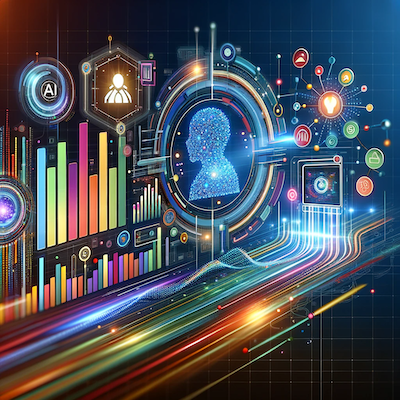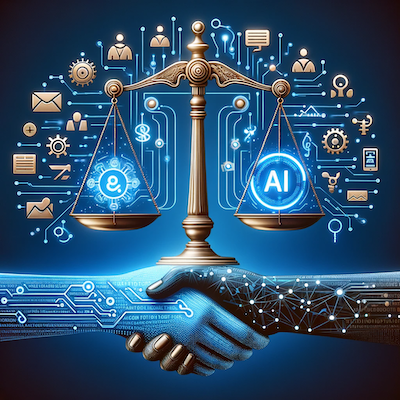The Synergy of AI and Creativity in Advertising
Blending Technology with Human Ingenuity

In the rapidly evolving landscape of digital advertising, the fusion of artificial intelligence (AI) and human creativity is more than a trend – it’s a revolution. This article delves into the transformative impact of AI on creative strategies, personalization, and the overall effectiveness of advertising campaigns in the digital era, exploring how this synergy is reshaping the way brands communicate with their audiences.
AI’s Role in Enhancing Creative Strategies
The integration of AI in advertising has ushered in a new era of innovation:
Automated Content Creation
AI’s capability to generate and refine creative content is groundbreaking. Leveraging machine learning algorithms, AI tools can draft ad copy, design visuals, and even create entire campaign concepts. These tools analyze vast datasets to produce content that resonates with target audiences, significantly reducing the time and resources traditionally required for content creation.
The advancements in natural language processing (NLP) and image generation AI have enabled the creation of highly engaging and relevant ad content. From generating catchy headlines to creating visually stunning ad banners, AI is transforming how creative content is conceived and executed. The ability of AI to test and iterate different versions of content quickly also means that the most effective messages can be identified and utilized more rapidly than ever before.
Data-Driven Insights for Creative Decisions
AI provides valuable insights by analyzing consumer behavior, market trends, and campaign performance data. These insights guide creative teams in making informed decisions, ensuring that their creative strategies are aligned with audience preferences and market dynamics.
By harnessing the power of big data, AI tools are able to identify patterns and insights that would be impossible for humans to discern. This includes understanding subtle shifts in consumer behavior, predicting trends, and even identifying new market segments. These insights enable advertisers to create highly targeted and effective campaigns that speak directly to the needs and desires of their audiences.

Personalization at Scale
AI excels at customizing content for individual preferences. By analyzing user data, AI enables the creation of highly personalized ads, making them more relevant and engaging for each viewer. This level of personalization was unimaginable in the era of traditional advertising.
Personalization goes beyond just addressing the consumer by name. AI algorithms can tailor ad messages, offers, and even creative elements based on a user’s past behavior, demographic information, and even real-time actions. This means that two people could see the same ad in entirely different formats, with each version optimized for maximum appeal to the individual viewer.
The Balance Between AI and Human Creativity
While AI brings efficiency and data-driven precision, the human touch remains vital. Here’s how the balance is maintained:
Human Insight and Emotional Connection
Despite AI’s analytical capabilities, human insight is essential for creating narratives that resonate emotionally with audiences. The nuanced understanding of cultural, social, and emotional factors remains a uniquely human trait that AI cannot replicate.
The creative process in advertising is not just about data and efficiency; it’s also about connecting with people on an emotional level. While AI can suggest themes or concepts that are likely to resonate based on data, it’s the human creator who infuses these themes with emotion, humor, and relatability. It’s this combination of AI’s efficiency and human empathy that creates truly compelling advertising.
Ethical Considerations and Responsible Use
The increasing use of AI in advertising raises important ethical questions, particularly around data privacy and consumer consent. Advertisers need to navigate these challenges carefully, ensuring that AI is used responsibly to maintain consumer trust.
Ethical considerations in AI-driven advertising are not just about compliance with laws and regulations; they are also about building and maintaining trust with consumers. This includes being transparent about how data is collected and used, ensuring fairness in how AI algorithms target ads, and being mindful of the potential biases in AI systems. Advertisers who prioritize ethical considerations in their use of AI are more likely to build long-term relationships with their customers.

AI’s Expanding Role in Creative Decision-Making
AI’s role in advertising is set to expand further:
Predictive Analytics and Trend Forecasting
AI’s advanced algorithms are now capable of predicting consumer behavior and market trends. This predictive power allows advertisers to anticipate changes in consumer preferences and stay ahead of market dynamics.
The use of predictive analytics in advertising is not just about understanding what consumers want now; it’s about anticipating their future needs and desires. This foresight enables advertisers to be proactive rather than reactive, creating campaigns that are aligned with emerging trends and consumer sentiments. Predictive analytics can also help advertisers identify potential challenges and opportunities in the market, allowing them to adjust their strategies accordingly.
Enhanced Cross-Channel Campaign Management
AI is enabling more integrated and cohesive advertising campaigns across multiple channels. By analyzing performance data across different platforms, AI optimizes campaign strategies for maximum engagement and effectiveness.
In today’s multi-channel world, consumers interact with brands across a variety of digital and physical touchpoints. AI’s ability to manage and optimize campaigns across these channels ensures a consistent and seamless brand experience for the consumer. This includes optimizing ad spend across channels, tailoring messages to the specific context of each channel, and ensuring that all elements of a campaign are working together in harmony.
Automated Optimization and Real-Time Adjustments
AI continuously analyzes campaign performance data, making real-time adjustments to optimize for engagement and conversion. This level of automation ensures that campaigns are constantly refined for the best possible results.
Real-time campaign optimization is a game-changer in advertising. AI systems can monitor the performance of an ad campaign and make adjustments on the fly – whether it’s changing a call-to-action, tweaking ad placement, or even altering creative elements. This dynamic approach to campaign management ensures that advertisers are always putting their best foot forward, maximizing the impact of their ad spend.
The Future of AI in Advertising
Looking ahead, the role of AI in advertising is poised for even greater growth:
Voice and Visual Search Optimization
As voice and visual search technologies become more prevalent, AI will play a crucial role in optimizing content for these new search modalities.
With the rise of smart speakers and visual search capabilities on smartphones, the way consumers search for information is changing. AI will be crucial in optimizing content for these new modalities, ensuring that brands remain visible and relevant in this evolving search landscape. This includes optimizing for natural language queries in voice search and ensuring that visual content is easily discoverable and engaging in visual search.
Immersive and Interactive Ad Experiences
With the rise of augmented reality (AR) and virtual reality (VR), AI will be instrumental in creating immersive and interactive ad experiences, offering new ways for brands to engage with consumers.
The potential for AR and VR in advertising is vast, and AI will be at the forefront of creating these experiences. From virtual try-ons in fashion and beauty to immersive product demonstrations in tech and automotive, AI-powered AR and VR experiences will offer consumers new and engaging ways to interact with brands. These experiences will not only be more engaging but also more informative, providing consumers with a deeper understanding of products and services.
Ethical AI and Consumer Trust
The future of AI in advertising will also involve a greater focus on ethical AI practices. Building and maintaining consumer trust will be paramount, and advertisers will need to ensure transparency, fairness, and respect for privacy in their use of AI technologies.
As AI becomes more sophisticated and pervasive, the need for ethical AI practices in advertising will become more pressing. This includes using AI in a way that respects consumer privacy, ensuring that AI systems are free from biases, and being transparent about how AI is being used in advertising campaigns. Advertisers who prioritize ethical AI practices will not only avoid potential pitfalls but also build stronger relationships with their consumers.
Conclusion
The intersection of AI and human creativity in advertising represents a frontier brimming with potential. By embracing this synergy, advertisers can unlock unprecedented levels of creativity and effectiveness in their campaigns. The future of advertising is not merely AI-driven; it’s AI-enhanced, where technology and human insight combine to create deeply resonant messaging with audiences.
